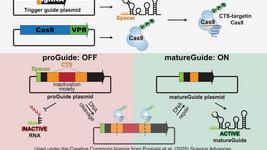CMN Weekly (21 October 2022) - Your Weekly CRISPR Medicine News
By: Karen O'Hanlon Cohrt - Oct. 21, 2022
Top picks
- Prime Medicine, a gene-editing company founded by base-editing pioneer David Liu began trading on the Nasdaq yesterday under the ticker symbol PRME, having raised $175 million in its IPO. The company is using prime- editing technology, a versatile, precise, efficient and broad gene-editing technology that is often dubbed CRISPR 3.0, which is designed to make only the right edit at the right position within a gene. In simple terms, a prime editor acts like as DNA word processor, by searching to find the precise place in the genome to edit and replacing the segment of faulty DNA with a correct copy of DNA.
- Gene Therapy could Change the Goalpost in Sickle Cell Disease. This writeup in BioSpace looks at the ongoing therapeutic landscape for sickle cell disease, including traditional gene therapy efforts as well as gene-editing approaches to treat or cure the disease.
Research
- In a manuscript recently shared on the pre-print server bioRxiv, researchers in Israel describe their efforts to exploit multiplex homology-directed repair (HDR) for disease and correction modelling of severe combined immunodeficiency (SCID) by CRISPR genome editing in human haematopoietic stem and progenitor cells (HSPCs). Using CRISPR-Cas9 reagents delivered via an adeno-associated virus 6 (AAV6) vector, the team engineered genotypes in healthy donor (HD)-derived HSPCs, thus eliminating the need for rare patient samples, to model both SCID and the therapeutic outcomes of gene-editing therapies via multiplexed HDR. The findings provide the field with methods to determine the optimal configuration for CRISPR-Cas9 gene correction of SCID and other recessive blood disorders, and highlight the feasibillity of translating those methods to perform gene correction in patient-derived HSPCs.
- A team in China has investigated the human genomic regions condensed with the protospacer-adjacent motifs (PAMs) of different CRISPR Cas enzymes. In an article published yesterday in Communications Biology, they report that Cas enzymes with GC-rich PAMs could interfere more with genomic regions that harbour enriched heritability for human complex traits and diseases. The results linked GC content across the genome to the functional genomic elements in the heritability enrichment of human complex traits. The authors propose that their findings provide a genetic overview of the effects of high-throughput genome editing on human complex traits.
- In an article published in EMBO reports today, researchers in Lithuania and the U.S. report the identification and characterisation of a new family of type V RNA-guided nuclease, Cas12l, that exclusively recognises a C-rich PAM. The team found that while the organisation of genes within Cas12l's CRISPR locus is similar to type II-B CRISPR-Cas9 systems, sequence analysis and functional studies establish it as a new family of type V effector. The team biochemically characterised Cas12l nuclease function and found that similarly to other type V nucleases, it exhibits collateral non-specific ssDNA and ssRNA cleavage activity that is triggered by ssDNA or dsDNA target recognition. One family member, Asp2Cas12l, was found to function in a heterologous cellular environment. The authors propose that Cas12l group of CRISPR-associated nucleases may be harnessed as genome-editing reagents.
Industry
- Excision BioTherapeutics will host a key opinion leader webinar about HIV and the company's ongoing Phase 1/2 trial evaluating EBT-101 as a potential cure for HIV. EBT-101 is the first CRISPR-based therapy to enter a clinical trial for HIV, and you can read more about how it works in our previous clinical update.
- Caribou Biosciences has presented a case report on long-term follow-up data for the first patient dosed in its Phase 1 ANTLER trial at the Lymphoma, Leukemia, & Myeloma Congress 2022. CB-010 is the first allogeneic (i.e. donor-derived) CAR-T cell therapy with a CRISPR-mediated PD-1 deletion to be cleared for a clinical trial. The new data reveals that the first patient enrolled in the ANTLER trial had no detectable signs of B-cell non-Hodgkin’s lymphoma 15 months after receiving a single dose of CB-010. You can read more about CB-010 and clinical data in our previous clinical trial update here.
- Kite Pharma and sythetic biology company Refuge Biotechologies have announced an exclusive license agreement that will allow Kite to use Refuge's proprietary gene expression platform to develop potential new therapies for blood cancers. Refuge’s platform is a synthetic biology system that uses an expression modulation strategy to repress or activate transcription of target genes. Early pre-clinical data suggest that the platform has potential to regulate target antigen-dependent gene expression to improve the efficacy and safety of first-generation CAR T-cell therapies.
- Gracell Biotechnologies announced this week that it has dosed the first patient in its Phase 2 portion of a registrational Phase 1/2 clinical trial to evaluate GC007g for the treatment of B-cell acute lymphoblastic leukaemia (B-ALL). The trial is currently ongoing in China. GC007g is Gracell's allogeneic, human leukocyte antigen (HLA)-matched, donor-derived, CD19-directed CAR-T cell therapy candidate under development for the treatment of a subset of B-ALL patients who relapsed after allogeneic human stem cell transplant.
Detection
- In an article published yesterday in Analytical and Bioanalytical Chemistry, a team in China provide proof of concept of a colorimetric biosensor for influenza H1N1 virus detection assay based on the CRISPR-Cas13a system and hybridisation chain reaction (HCR). In the assay, influenza H1N1-derived RNA activates the trans-cleavage activity of Cas13a, which cleaves the special RNA sequence (-UUU-) of the probe, further initiating HCR to generate G-rich DNA. Abundant G-quadruplex/hemin is formed in the presence of hemin, which in turn catalyses a colorimetric reaction. The authors report that the colorimetric biosensor exhibited a linear relationship from 10 pM to 100 nM, with an assay detection limit of 0.152 pM. The team propose their new sensitive detection method for influenza virus as a promising rapid influenza diagnostic test.
Reviews
- Application of Gene Therapy in Hemophilia. This review summarises the bench and clinical work that has been undertaken within the field of gene therapy to treat haemophilia in recent years. The authors also summarise the challenges and prospects of gene therapy to provide directions for future scientific research in this field.
- Alternative antiviral approaches to combat influenza A virus. This review discusses the characteristics and mechanisms of mutations and reassortments that contribute to the evolution of Influenza A virus (IAV). The authors also discuss several alternative RNA-targeting antiviral approaches, namely the CRISPR-Cas13 systems, RNA interference (RNAi), and antisense oligonucleotides (ASO) as potential antiviral approaches against IAV.
- Nanomaterial-assisted CRISPR gene-engineering - A hallmark for triple-negative breast cancer therapeutics advancement. This review aims to detail all possible genetic mechanisms of triple-negative breast cancer (TNBC) occurrence and available treatments and gene therapies for TNBC, as well as providing an overview of the delivery system and utilisation of CRISPR-nano complex in TNBC. Lastly, the review summarises recent advances and related toxicity of CRISPR-nano complex towards clinical trials for TNBC.
- Clustered Regularly Interspaced short palindromic repeats-Based Microfluidic System in Infectious Diseases Diagnosis: Current Status, Challenges, and Perspectives. This review highlights the mechanisms of CRISPR-Cas biosensing and cutting-edge microfluidic devices including paper, digital, and integrated wearable platforms. The authors discuss strategies to simplify sample pre-treatment, improve diagnostic performance, and achieve integrated detection, as well as the current challenges and future perspectives contributing to the development of more effective CRISPR-based microfluidic diagnostic systems.
Huh, Heh, Wow
- SCiFi Foods, a Start-Up Using CRISPR, Thinks It Can Save the Planet — And Your Burger. This piece in the New York Sun brings news about SCiFi Foods, a startup based in the San Francisco Bay Area, that is using CRISPR to cultivate beef outside of the cow. The company's mission is to develop an affordable and environmentally sustainable way to eat beef.
To get more of the CRISPR Medicine News delivered to your inbox, sign up to the free weekly CMN Newsletter here.
Tags
CLINICAL TRIALS
IND Enabling
Phase I
Phase II
Phase III
Gastric Cancer and Colorectal Cancer, CRC, (NCT07166263)
Sponsors:
Base Therapeutics (Shanghai) Co., Ltd.
Sponsors:
Base Therapeutics (Shanghai) Co., Ltd.
IND Enabling
Phase I
Phase II
Phase III
Relapsed or Refractory Acute Myeloid Leukemia, AML, (NCT06541444)
Sponsors:
Base Therapeutics (Shanghai) Co., Ltd.
Sponsors:
Base Therapeutics (Shanghai) Co., Ltd.
IND Enabling
Phase I
Phase II
Phase III







